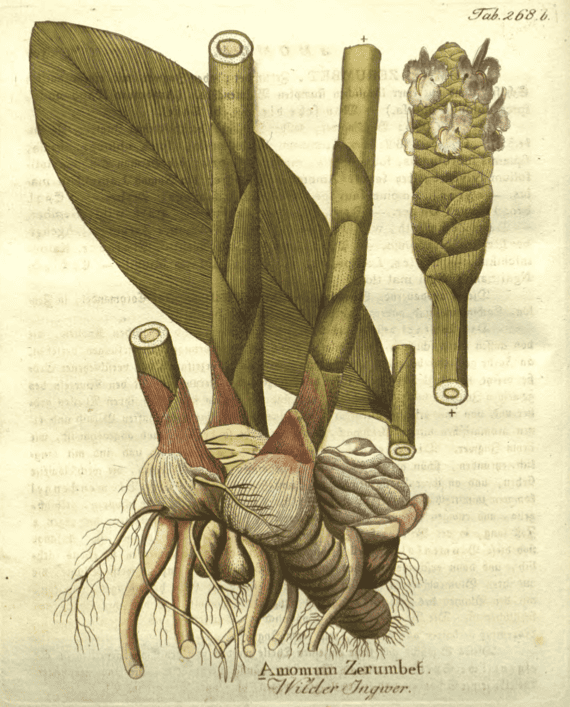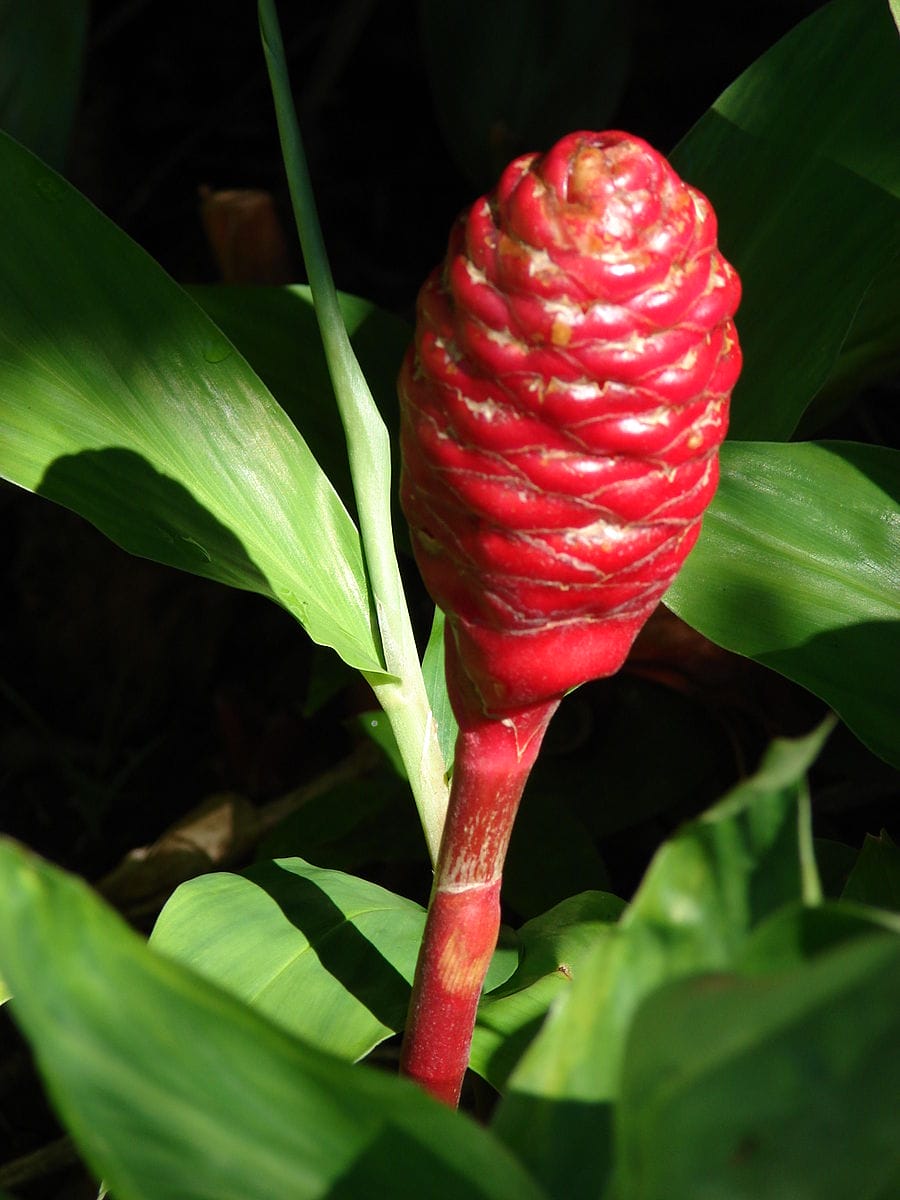Zerumbet
Mahabhari Vacha (Ayurveda)
Zarambad ,
Narkachoor (Unani)
Icones Plantarum Medcio-oeconomico , Vietz, 1800
Zingiber zerumbet
(Photo by
Forest & Kim Starr ) (
Wikimedia )
Botanical name: Zingiber zerumbet (syn. Z. spurium, Amomum zerumbet, A. spurium, A. sylvestre)
Parts used: Root
Temperature & Taste: Warm, dry. Pungent, Aromatic
Uses: 1. Warms the Lungs, Clears Cold Phlegm:
-Cold-type Cough, Asthma
2. Warms the Stomach, Moves the Qi:
-indigestion, cold type abdominal pain
3. Strengthens the Heart, Moves the Blood, Regulates Qi:
-Heart weakness; Palpitations
-Hemiplegia
-Exhilarant; promotes Happiness; for Sadness, Melancholy
4. Moves the Blood, Resolves Masses:
–recently shown to have a wide-ranging effect against various Cancers
Dose: Powder: 1–3 grams
Substitutes:: 1. Doronicum and Zerumbet have been substituted for one another.
2. Zedoary and Zerumbet were often confused, and are very similar.
3. Galangal (
Alpinia ) is used synonymously with Zerumbet in parts of India
4. Ginger (
Waring )
5. Zerumbet is used as a substitute for Delphinium denudatum in Unani.
Main Combinations: In Unani medicine, Zerumbet is often combined with Doronicum. Together they warm and strengthen the Heart and Stomach.
1. Palpitations, Shortness of Breath, diseases of Black Bile:
i. Zerumbet, Doronicum, Pearl, Amber, Coral, Red Behen, White Behen, Silkworm Cocoons, Spikenard, Long Pepper, Musk (Syrian ‘
Book of Medicine ‘, Budge, 1913)
ii. Zerumbet, Doronicum, Licorice juice, Cassia, Costus, Long Pepper, Storax, Saffron, Musk, Pearl, Myrrh (Syrian ‘
Book of Medicine ‘, Budge, 1913)
iii. Zerumbet, Doronicum, Euphorbium, Coral, Pearl, Pyrethrum, Clove, Mandrake seed, Saffron, Camphor (Syrian ‘
Book of Medicine ‘, Budge, 1913)
2. Heart Pain, Zerumbet, Doronicum, Musk, Camphor, Pearl, Amber, Coral, Gold, Silver, Cinnamon, Costus (Syrian ‘
Book of Medicine ‘, Budge, 1913)
3. Strengthen the Heart, Zerumbet, Cinnamon, Galangal, Saffron.
4. Diseases of the Heart, Zerumbet, Doronicum, Pearl, Coral, Tabasheer, Silkworm Cocoon, Clove, Castoreum, made into an Electuary with Honey. (Syrian ‘
Book of Medicine ‘, Budge, 1913)
5. Palpitations with Fear, Zerumbet, Doronicum, Ox Tongue, take 3 times per month with water and wine. (Syrian ‘
Book of Medicine ‘, Budge, 1913)
6. Palpitations, Epilepsy, Hemiplegia, Zerumbet with Doronicum, Pearl, Amber, Coral. (Unani)
7. To promote Happiness and relieve Melancholy, Zerumbet with Borage, Balm, Basil seed, Cinnamon, Amber, Coral, Saffron. (
Dispensatory of Ibn at Timid )
8. Stomach cold and weakness, Zerumbet with Cardamon, Ginger, Cinnamon, Cyperus rotundus.
Major Formulas: Electuary for Pregnancy (Unani) Electuary of Aloeswood of Avicenna Electuary of Aloeswood (Persica) Electuary of Steel (Unani) Christian Electuary (Unani) The Great Electuary Letificans Cooling Electuary (Unani)
Cautions: None noted
Toxicity: Non-Toxic.
–
Acute and 28-Day Subchronic Oral Toxicity of an Ethanol Extract of Zingiber zerumbet (L.) Smith in Rodents. –
Absence of Genotoxic and Mutagenic Effects of Zingiber zerumbet (L.) Smith (Zingiberaceae) Extract. Main Preparations used:
GENERAL / REVIEWZingiber zerumbet (L.) Smith: A Review of Its Ethnomedicinal, Chemical, and Pharmacological Uses. Corrigendum to “Zingiber zerumbet (L.) Smith: A Review of Its Ethnomedicinal, Chemical, and Pharmacological Uses”. Recent Updates on the Phytochemistry, Pharmacological, and Toxicological Activities of Zingiber zerumbet (L.) Roscoe ex Sm. Chemistry of zerumbone. 2. Regulation of ring bond cleavage and unique antibacterial activities of zerumbone derivatives. Antimicrobial activities of the rhizome extract of Zingiber zerumbet Linn. Antibacterial and antimutagenic activities of novel zerumbone analogues. Variation in secondary metabolite production as well as antioxidant and antibacterial activities of Zingiber zerumbet (L.) at different stages of growth. Antiinflammatory and antinociceptive activities of Zingiber zerumbet methanol extract in experimental model systems. Anti-inflammatory effect of zerumbone on acute and chronic inflammation models in mice. Preliminary analysis of the anti-inflammatory activity of essential oils of Zingiber zerumbet. Preliminary analysis of the antinociceptive activity of zerumbone. Antinociceptive activity of the essential oil of Zingiber zerumbet. Antiinflammatory and antinociceptive activities of Zingiber zerumbet methanol extract in experimental model systems. Antinociceptive effect of the essential oil of Zingiber zerumbet in mice: possible mechanisms. Major Bioactive Compounds in Essential Oils Extracted From the Rhizomes of Zingiber zerumbet (L) Smith : A Mini-Review on the Anti-allergic and Immunomodulatory Properties. Immunomodulatory effects of zerumbone isolated from roots of Zingiber zerumbet. Exploring the immunomodulatory and anticancer properties of zerumbone. Major Bioactive Compounds in Essential Oils Extracted From the Rhizomes of Zingiber zerumbet (L) Smith : A Mini-Review on the Anti-allergic and Immunomodulatory Properties. Immunosuppressive effects of the standardized extract of Zingiber zerumbet on innate immune responses in Wistar rats. Zerumbone reduced the inflammatory response of acute lung injury in endotoxin-treated mice via Akt-NFκB pathway. Zerumbone from Zingiber zerumbet Ameliorates Lipopolysaccharide-Induced ICAM-1 and Cytokines Expression via p38 MAPK/JNK-IκB/NF-κB Pathway in Mouse Model of Acute Lung Injury. Antisecretory, gastroprotective, antioxidant and anti-Helicobcter pylori activity of zerumbone from Zingiber zerumbet (L.) Smith. Suppression of dextran sodium sulfate-induced colitis in mice by zerumbone, a subtropical ginger sesquiterpene, and nimesulide: separately and in combination. Zingiber zerumbet L. (Smith) extract alleviates the ethanol-induced brain damage via its antioxidant activity. Antinociceptive and Anti-Inflammatory Effects of Zerumbone against Mono-Iodoacetate-Induced Arthritis. Nephroprotective effects of Zingiber zerumbet Smith ethyl acetate extract against paracetamol-induced nephrotoxicity and oxidative stress in rats. Beneficial impact of Zingiber zerumbet on insulin sensitivity in fructose-fed rats. Consumption of Polyphenol-Rich Zingiber Zerumbet Rhizome Extracts Protects against the Breakdown of the Blood-Retinal Barrier and Retinal Inflammation Induced by Diabetes. Zerumbone, a Phytochemical of Subtropical Ginger, Protects against Hyperglycemia-Induced Retinal Damage in Experimental Diabetic Rats. The Ethanol Extract of Zingiber zerumbet Attenuates Streptozotocin-Induced Diabetic Nephropathy in Rats. Zerumbone, a tropical ginger sesquiterpene, ameliorates streptozotocin-induced diabetic nephropathy in rats by reducing the hyperglycemia-induced inflammatory response. Platelet-activating factor (PAF) receptor-binding antagonist activity of Malaysian medicinal plants. Lipid-lowering effects of zerumbone, a natural cyclic sesquiterpene of Zingiber zerumbet Smith, in high-fat diet-induced hyperlipidemic hamsters. HEPATOPROTECTIVEDietary zerumbone, a sesquiterpene, ameliorates hepatotoxin-mediated acute and chronic liver injury in mice. Hepatoprotective Effects of Zerumbone against Paracetamol-Induced Acute Hepatotoxicity in Rats.
FATTY LIVERZerumbone, a Natural Cyclic Sesquiterpene of Zingiber zerumbet Smith, Attenuates Nonalcoholic Fatty Liver Disease in Hamsters Fed on High-Fat Diet. The ethanol extract of Zingiber zerumbet Smith attenuates non-alcoholic fatty liver disease in hamsters fed on high-fat diet. Anti-tumour promoter activity in Malaysian ginger rhizobia used in traditional medicine. Identification of zerumbone in Zingiber zerumbet Smith as a potent inhibitor of 12-O-tetradecanoylphorbol-13-acetate-induced Epstein-Barr virus activation. Cytotoxicity of the rhizome of medicinal plants. Antibacterial and antimutagenic activities of novel zerumbone analogues. Zerumbone inhibits tumor angiogenesis via NF-κB in gastric cancer. Zerumbone, Sesquiterpene Photochemical from Ginger, Inhibits Angiogenesis. Chemoprevention of azoxymethane-induced rat aberrant crypt foci by dietary zerumbone isolated from Zingiber zerumbet. Zerumbone, a Southeast Asian ginger sesquiterpene, markedly suppresses free radical generation, proinflammatory protein production, and cancer cell proliferation accompanied by apoptosis: the alpha,beta-unsaturated carbonyl group is a prerequisite. Zerumbone, a tropical ginger sesquiterpene, activates phase II drug metabolizing enzymes. Antitumor effects of zerumbone from Zingiber zerumbet in P-388D1 cells in vitro and in vivo. Zerumbone abolishes NF-kappaB and IkappaBalpha kinase activation leading to suppression of antiapoptotic and metastatic gene expression, upregulation of apoptosis, and downregulation of invasion. Histone deacetylase inhibitors from the rhizomes of Zingiber zerumbet. Key cell signaling pathways modulated by zerumbone: role in the prevention and treatment of cancer. Exploring the immunomodulatory and anticancer properties of zerumbone. Potential of Zerumbone as an Anti-Cancer Agent. Zerumbone suppresses IKKα, Akt, and FOXO1 activation, resulting in apoptosis of GBM 8401 cells. Zerumbone down-regulates chemokine receptor CXCR4 expression leading to inhibition of CXCL12-induced invasion of breast and pancreatic tumor cells. Zerumbone, a tropical ginger sesquiterpene, inhibits colon and lung carcinogenesis in mice. In vitro ultramorphological assessment of apoptosis induced by zerumbone on (HeLa). Effects of a new synthetic zerumbone pendant derivative (ZPD) on apoptosis induction and anti-migratory effects in human cervical cancer cells. Zerumbone increases oxidative stress in a thiol-dependent ROS-independent manner to increase DNA damage and sensitize colorectal cancer cells to radiation. Zerumbone, a Cyclic Sesquiterpene from Zingiber zerumbet Induces Apoptosis, Cell Cycle Arrest, and Antimigratory Effects in SW480 Colorectal Cancer Cells. Zerumbone inhibits tumor angiogenesis via NF-κB in gastric cancer. Zerumbone, a Sesquiterpene, Controls Proliferation and Induces Cell Cycle Arrest in Human Laryngeal Carcinoma Cell Line Hep-2. Zerumbone induces apoptosis in T-acute lymphoblastic leukemia cells. Potential chemoprevention of diethylnitrosamine-initiated and 2-acetylaminofluorene-promoted hepatocarcinogenesis by zerumbone from the rhizomes of the subtropical ginger (Zingiber zerumbet). Zerumbone induced apoptosis in liver cancer cells via modulation of Bax/Bcl-2 ratio. Inclusion Complex of Zerumbone with Hydroxypropyl- β -Cyclodextrin Induces Apoptosis in Liver Hepatocellular HepG2 Cells via Caspase 8/BID Cleavage Switch and Modulating Bcl2/Bax Ratio. Zerumbone suppresses the potential of growth and metastasis in hepatoma HepG2 cells via the MAPK signaling pathway. Zerumbone targets the CXCR4-RhoA and PI3K-mTOR signaling axis to reduce motility and proliferation of oral cancer cells. Zerumbone down-regulates chemokine receptor CXCR4 expression leading to inhibition of CXCL12-induced invasion of breast and pancreatic tumor cells. Zerumbone, a Southeast Asian Ginger Sesquiterpene, Induced Apoptosis of Pancreatic Carcinoma Cells through p53 Signaling Pathway. Lipid-lowering effects of zerumbone, a natural cyclic sesquiterpene of Zingiber zerumbet Smith, in high-fat diet-induced hyperlipidemic hamsters. Zerumbone, a ginger sesquiterpene, induces apoptosis and autophagy in human hormone-refractory prostate cancers through tubulin binding and crosstalk between endoplasmic reticulum stress and mitochondrial insult. An in vitro evaluation of anthelmintic activity of Zingiber zerumbet rhizomes and Cucurbita maxima seeds on Pheretima posthuma model: A comparative study. An in vitro evaluation of the anthelmintic activity of Hedychium spichatum rhizomes and Zingiber zerumbet rhizomes on the Pheritima Posthuma model: A comparative study.
 Icones Plantarum Medcio-oeconomico, Vietz, 1800
Icones Plantarum Medcio-oeconomico, Vietz, 1800 Zingiber zerumbet
Zingiber zerumbet